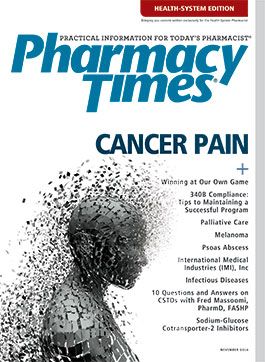Publication
Article
Pharmacy Practice in Focus: Health Systems
Pain in Patients with Cancer
Author(s):
Pain is an important concern for patients with cancer, although not every patient with cancer will experience pain.
Pain is an important concern for patients with cancer, although not every patient with cancer will experience pain. Thirty percent of patients with cancer have pain at the time of diagnosis, and 65% to 85% have pain when their disease is advanced.1-4 Pain occurs in 59% of patients receiving anticancer treatments and in 33% of patients after curative treatment.2 The various types of cancer pain include acute, chronic, persistent, breakthrough, bone, neuropathic, and multimechanistic.
A patient may experience discomfort from the cancer itself or when a tumor spreads to bones or organs, involves the nerves, or causes spinal cord compression. Pain can also be a side effect of cancer treatments, including pain due to certain procedures or tests, such as diagnostic or prognostic tissue biopsy, blood sampling, spinal tap, and bone marrow aspiration/biopsy. Pain can arise from a surgical site or as an adverse effect of chemotherapy and/or radiation. When cancer pain is not treated properly, it can lead to fatigue, depression, anger, isolation, and loneliness.
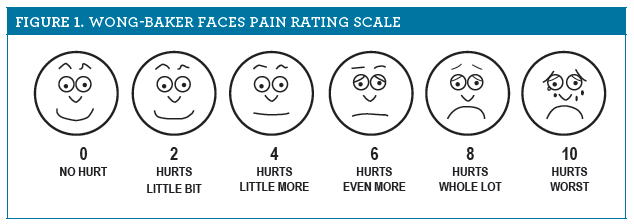
Pain Scales
Several scales and tools are available to help assess patients:
- The Wong-Baker FACES Pain Rating Scale was created to help children identify their pain (Figure 1). This scale can also be helpful for patients who are unable to verbally explain or express their pain.
- The 0 to 10 Numeric Pain Rating Scale is a very common scale by which patients rate their pain on a level from 1 to 10 (Figure 2).
- The Pain Quality Assessment Scale is a more complex tool that can be used to help patients identify different aspects and types of pain (Figure 3).

When cognitive impairment is encountered (eg, in the last days of life, when the ability to communicate is limited), observation of pain-related behaviors is used to assess the presence of pain, not severity. Affected patients should be observed for grimacing and other facial expressions, body movements, and changes in interactions and routine, all of which may indicate that pain is present.
It is important to identify the pain site, obtain a description of the pain, and then categorize the pain at each site. Patients with cancer commonly have a multimechanistic pain syndrome. Therefore, the choice of pain medications will be guided by the patient’s description of pain.
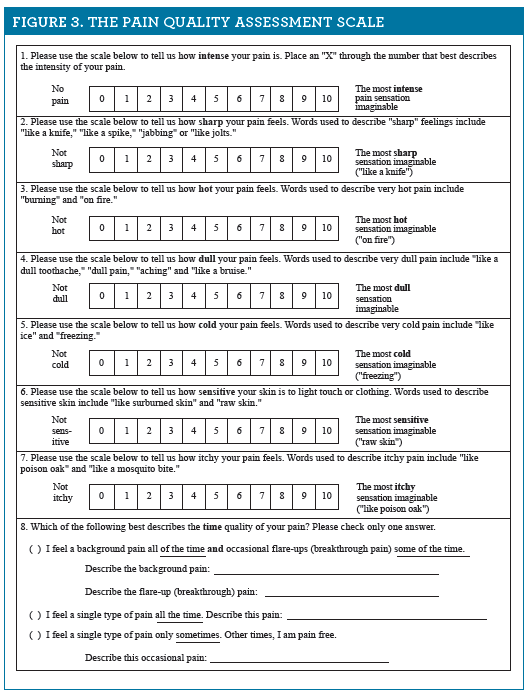
The World Health Organization (WHO) has developed a 3-step ladder for cancer pain in adults (Figure 4).5 In the first step, the choice of treatment for mild pain is nonopioids (aspirin and acetaminophen); acetaminophen and nonsteroidal anti-inflammatory drugs (NSAIDs) are acceptable for the treatment of cancer pain at any stage of the WHO analgesic ladder.2 Combining acetaminophen or an NSAID with an opioid can reduce pain by a different mechanism, thereby decreasing opioid consumption.6 Using acetaminophen or an NSAID can help reduce the opioid dose when sedation, confusion, or dizziness caused by an opioid are bothersome. NSAIDs can also relieve pain due to inflammation, and study results have shown they are superior to placebo in controlling cancer pain.2 However, the use of NSAIDs can cause gastrointestinal bleeding, platelet dysfunction, and renal failure. Acetaminophen should be avoided or used with caution in patients with liver disease, with renal insufficiency, or who consume a significant amount of alcohol. If acetaminophen is used in these individuals, a reduced maximum dose of 2000 mg/day is recommended.
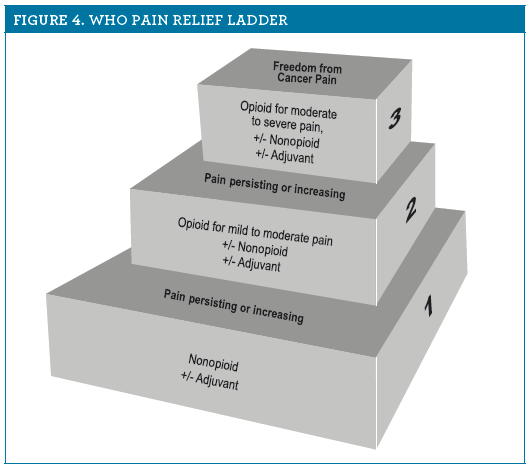
The second step on the WHO ladder is the treatment of mild to moderate pain with mild opioids, such as tramadol.5 There is some criticism of this second step because of a lack of study results showing a clear difference in the effectiveness of the recommended drugs in the first and second levels.2 Some researchers have reported that the effectiveness of the second step has a time limit of 30 to 40 days for most patients and that most of the weak opioids have a ceiling limit.2 Others have proposed elimination of the second step in favor of using low-dose morphine or low doses of strong opioids in combination with nonopioid analgesics.2
The third step on the WHO ladder involves the transition to using stronger opioids.5 Several opioids are available, including morphine, hydromorphone, fentanyl, hydrocodone (in combination with acetaminophen/ibuprofen), methadone, buprenorphine, tapentadol, and oxycodone. In terms of efficacy, no study results show that one opioid is superior to another.2,6 Overall, morphine is the drug of choice for managing moderate to severe chronic cancer pain. Morphine is widely tolerated, simple to administer, and cost-effective; it also is the only opioid in the WHO essential drug list for adults and children with pain.2 However, morphine should be used cautiously in patients with hepatic and renal failure.2 Other opioids in various formulations may offer alternatives (Table 1).
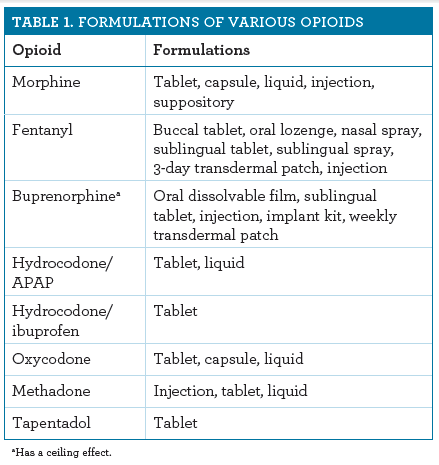
Adjuvant pain medications can be used at any point during the ladder. The use of the right drug at the right dose and time is effective 80% to 90% of the time.5
The WHO recommends a 2-step ladder for children.7 The first step is treating mild pain with acetaminophen or ibuprofen. In children older than 3 months, acetaminophen and ibuprofen are preferred. For children younger than 3 months, the only option is acetaminophen. Ibuprofen is the NSAID of choice due to its history of efficacy and safety in children.
The second step for children with severe pain is the use of opioids, such as morphine. However, other opioids can be used if a patient cannot tolerate morphine. Morphine offers the advantage of being available orally as liquid and tablets, as well as a solution that can be given intravenously, subcutaneously, or intramuscularly (although these routes can be painful) and rectally if all other routes are unavailable. Dosing and specifics of pediatric pain medications, including adjuvants, is beyond the scope of this article. The oral route is preferred for managing pain. However, if a patient is in severe pain and needs immediate relief, the subcutaneous route or intravenous route is an option. A conversion table can be used to determine the appropriate dose (Table 2).

For continuous pain, a short-acting pain medication should be given around-the-clock.8 Once the patient is stabilized, it is appropriate to change to an extended-release or long-acting product. The dose of a long-acting product should equal the milligram dose of the short-acting product the patient was receiving. For example, a patient is stabilized on immediate-release morphine sulfate 5 mg every 4 hours around the clock. This equals 30 mg of morphine in 24 hours. The conversion to long-acting morphine would be 15 mg every 12 hours or 30 mg daily of a 24-hour product, such as Kadian.
If possible, the same short-acting opioid should be used for breakthrough pain as the long-acting product (eg, use immediate-release morphine if the patient is taking long-acting morphine; use immediate-release oxycodone if the patient is using long-acting oxycodone). This rule does not apply to methadone due to its long half-life. A typical breakthrough dose is 10% to 20% of the total daily opioid dose given every 4 hours, as needed. Patients should be prescribed a breakthrough pain medication.
Pain can also be treated with nonpharmacologic options, including the application of heat to the area of pain. This could be in the form of a hot pack, a hot water bottle, a heating pad, or immersion in warm water. Pain can also be relieved by applying cold to the site in the form of an ice pack, a towel soaked in ice water, or a cool gel pack. Other forms of nonpharmacologic treatments include transcutaneous electrical nerve stimulation, massage therapy, exercise, chiropractic techniques, relaxation techniques, and hypnosis.9
End Note
Pain can present in many different forms during cancer. It is important to take an accurate patient history and treat the correct pain. The choice of medication will depend on age, the presence of other disease states, and drug interactions. With the correct pain medication, dose, and frequency, pain can be controlled and relieved.
Michelle Smith, PharmD, BCPS, received her degree from the University of Wyoming School of Pharmacy and completed a residency at Thomas Jefferson University Hospital. She has experience in geriatrics, medication therapy management, hospice, and medical writing.
References
- Levy MH. Pharmacologic treatment of cancer pain. N Engl J Med. 1996;335(15):1124-1132.
- Ripamonti CI, Santini D, Maranzano E, Berti M, Roila F; ESMO Guidelines Working Group. Management of cancer pain: ESMO clinical practice guidelines. Ann Oncol. 2012;23 (suppl 7):vii39-vii154.
- Tsuzuki S, Park SH, Eber MR, Peters CM, Shiozawa Y. Skeletal complications in cancer patients with bone metastases. Int J Urol. 2016;23(10):825-832. doi:10.1111/iju.13170.
- Pharo GH, Zhou L. Pharmacologic management of cancer pain. J Am Osteopath Assoc. 2005;105(11 suppl 5):S21-S28.
- WHO’s cancer pain ladder for adults. World Health Organization website. who.int/cancer/palliative/painladder/en/. Accessed October 3, 2016.
- Paice JA, Ferrell B. The management of cancer. CA Cancer J Clin. 2011;61(3):157-182. doi: 10.3322/caac.20112.
- WHO guidelines on the pharmacological treatment of persisting pain in children with medical illnesses. World Health Organization website. who.int/en. Accessed October 3, 2016.
- Swarm R, Pickar A, Anghelescu D, et al; NCCN Adult Cancer Pain. Adult cancer pain. J Natl Compr Canc Netw. 2010;8(9):1046-1086.
- Buga S, Sarria JE. The management of pain in metastatic bone disease. Cancer Control. 2012;19(2):154-166.
